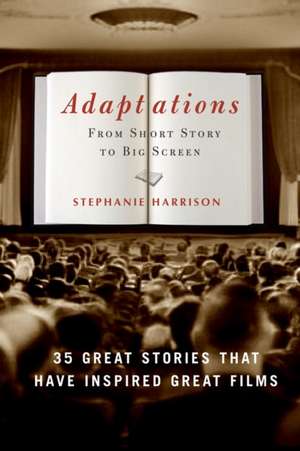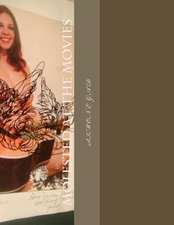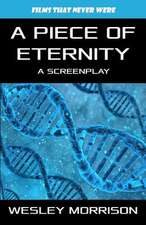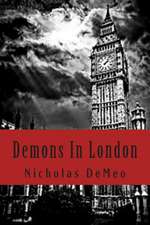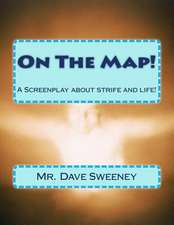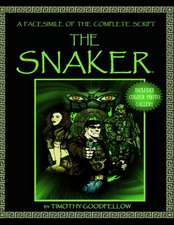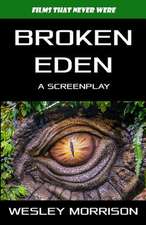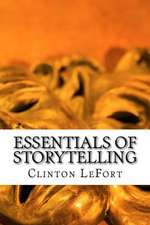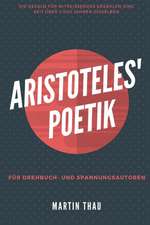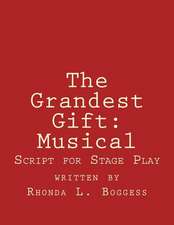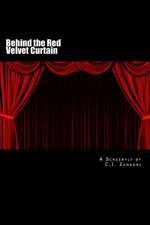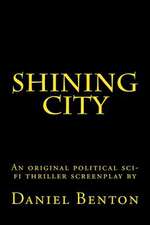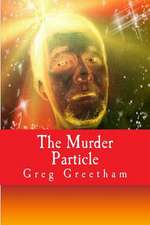Adaptations: 35 Great Stories That Have Inspired Great Films
Autor Stephanie Harrisonen Limba Engleză Paperback – 31 ian 2005
Memento, All About Eve, Rear Window, Rashomon, and 2001: A Space Odyssey are all well-known and much-loved movies, but what is perhaps a lesser-known fact is that all of them began their lives as short stories. Adaptations gathers together 35 pieces that have been the basis for films, many from giants of American literature (Hemingway, Fitzgerald) and many that have not been in print for decades (the stories that inspired Bringing Up Baby, Meet John Doe, and All About Eve).
Categorized by genre, and featuring movies by master directors such as Steven Spielberg, Stanley Kubrick, Robert Altman, Frank Capra, and John Ford, as well as relative newcomers such as Chris Eyre and Christopher Nolan, Adaptations offers insight into the process of turning a short story into a screenplay, one that, when successful, doesn’t take drastic liberties with the text upon which it is based, but doesn’t mirror its source material too closely either. The stories and movies featured in Adaptations include:
•Philip K. Dick’s “The Minority Report,” which became the 2002 blockbuster directed by Steven Spielberg and starring Tom Cruise
•“The Harvey Pekar Name Story” by reclusive graphic artist Harvey Pekar, whose life was the inspiration for American Splendor, winner of the 2003 Sundance Grand Jury Prize
•Hagar Wilde’s “Bringing Up Baby,” the basis of the classic film Bringing Up Baby, anthologized here for the first time ever
•“The Swimmer” by John Cheever, an example of a highly regarded story that many feared might prove unadaptable
•The predecessor to the beloved holiday classic A Christmas Story, “Red Ryder Nails the Hammond Kid” by Jean Shepherd
Whether you’re a fiction reader or a film buff, Adaptations is your behind-the-scenes look at the sometimes difficult, sometimes brilliantly successful process from the printed page to the big screen.
Preț: 149.92 lei
Nou
Puncte Express: 225
Preț estimativ în valută:
28.70€ • 31.18$ • 24.12£
28.70€ • 31.18$ • 24.12£
Carte disponibilă
Livrare economică 31 martie-14 aprilie
Preluare comenzi: 021 569.72.76
Specificații
ISBN-13: 9781400053148
ISBN-10: 1400053145
Pagini: 640
Dimensiuni: 155 x 237 x 35 mm
Greutate: 0.69 kg
Editura: Three Rivers Press (CA)
ISBN-10: 1400053145
Pagini: 640
Dimensiuni: 155 x 237 x 35 mm
Greutate: 0.69 kg
Editura: Three Rivers Press (CA)
Notă biografică
Stephanie Harrison teaches in the state university system of Florida.
Extras
Chapter One
THE DIRECTORS:TRANSLATORS,MAGICIANS, COLLABORATORS,AND THIEVES
“Jerry and Molly and Sam”
by Raymond Carver
—Short Cuts, directed by Robert Altman, 1993
“Blow-Up”
by Julio Cortázar
—Blow-Up, directed by Michelangelo Antonioni, 1966
“Your Arkansas Traveler”
by Budd Schulberg
—A Face in the Crowd, directed by Elia Kazan, 1957
“It Had to Be Murder”
by Cornell Woolrich
—Rear Window, directed by Alfred Hitchcock, 1954
Movies have to be about something. They can dazzle us with special effects, wow us with an eight-minute tracking shot, or intrigue us with a cartoonlike color palette. But we still expect a story. A story visually told, perhaps—but a story nonetheless.
And that’s why “film feeds off literature like sharks off a marlin,” as film theorist George Bluestone once said. Director Stanley Kubrick was a compulsive reader, sometimes tearing through a book a day in his constant search for new material. Alfred Hitchcock told of imagining the shape of a film, then having to search for a story to fit his visualization. Howard Hawks claimed that the hardest part of making a movie was finding a good story, then figuring out how to tell it. Steven Spielberg agrees. Even Michelangelo Antonioni was a reader, although he claimed the best way to approach a book was to read it, then forget it. Directors, especially those of the auteur ilk, get a lot of credit for their successes and a lot of blame for their failures. But, like prominent CEOs, they depend a great deal on others. Unless directors write their own material, they will have to go to the source: writers. And there are as many approaches to this as there are directorial personalities.
The Translator: Altman and Short Cuts
In 1990, while flying home from Italy, Robert Altman read a book of short stories by Raymond Carver. “I was so moved by the way he told stories,” he later said, “what he told and what he didn’t tell and how he made a story out of the slightest little incident. I was just amazed by it and I thought this is what we should do in film.”
For just over a decade, from the early 1970s through the mid-’80s, Carver led the return to realistic fiction that revels in the quotidian. His stories feature hard-drinking, unhappily married, working-class folk who live, as Tess Gallagher, Carver’s second wife, puts it, “with no safety net and no imagination of a safety net.” The residents of “Carver Country” drift through life—often in an alcoholic haze—and end in a place very close to where they started. The epiphanies, if you can call them that, are small and internal. As his friend Tobias Wolff has said, Carver “is not a particularly quotable writer. That’s one of his virtues, that he never tried to achieve a beautiful line. It’s the steadiness and quietness of the prose that creates his sense of reality.” And it’s reality Carver was after: “As far as I’m concerned,” he told an interviewer, “the best art has its reference points in real life.”
There is an autobiographical element to his work. Like many of his characters, Carver grew up working class and was, for most of his adult life, a dedicated alcoholic. Throughout his first marriage he was plagued by financial concerns that kept him from his writing. Of his work, he said, “I’m just bearing witness to something I know something about. Most things in the world I don’t know anything at all about. . . . I’m bearing witness to what I can.” Because of his concern with small moments in the lives of ordinary people, Carver is often compared to Chekhov, and his declarative prose style invites comparison to Hemingway. Yet his sensibility is unquestionably reflective of his own generation. His pared-down realism, tinged with a dash of hopelessness, suited the period following Watergate, and by the time of his death from lung cancer in 1988, Carver was arguably the most influential literary writer in the country.
Enter Altman. If ever a director was poised to exploit the contemporary short story—now so firmly associated with Carver—Altman was that director. By the time he discovered Carver’s stories, Altman had already directed twenty-five feature films (including M*A*S*H, McCabe and Mrs. Miller, The Long Goodbye, and Thieves Like Us), not to mention countless television episodes. He’d honed a signature directorial style consisting of overlapping dialogue, improbably large casts, mock-documentary realism, improvisation, and the use of nonprofessional actors. Most important, though, he’d already made Nashville, a rambling narrative that loosely weaves the story lines of twenty-four characters, without, as Pauline Kael put it, the “clanking of plot.” Arguably one of the best films ever made—it appears on countless top-100 lists—Nashville’s lack of narrative thrust baffled many. When asked about his reputation as a “problem director,” Altman stated, “I’m not difficult. My work may be difficult, but if in fact it is difficult, it just further enforces what I have to say: that all I make films about is what I see and the way things appear to me.”
So why wouldn’t Altman admire Carver’s stories? There’s an obvious link between a writer who is “just bearing witness” and a filmmaker who is making films about “the way things appear to me.” Between a writer who eschews quotable lines and a director who uses untrained actors. Between a writer who strives for realistic-sounding dialogue through the use of stammers, pauses, and repeated lines and a director who strives for the same through the use of overlapping sound. Between a writer who resists neatly tied-up endings and a director who has said, “Many people, I guess, want to know exactly what it is they’re supposed to think. . . . Well, my message is that I am not going to do their work for them.” Beyond all this, though, there are deeper affinities. They both look upon their characters with an unflinching but surprisingly nonjudgmental eye. They are both interested in the hyperreality of small moments. And they both balance intuitiveness with painstaking craftsmanship. And yet, it’s one thing for Altman to have admired Carver’s stories; it’s quite another that he knew how to translate them well for film. Only someone with Altman’s résumé could have seen the possibilities in a random selection of nine unconnected, unplotted stories. And, of course, one poem.
In the case of Short Cuts, the role of translator is one Altman wears gracefully, but not naturally. His relationship with writers has often been rocky, the writers forced to watch as their words are reduced to rubble. Brian McKay, who wrote the screenplays for several of Altman’s films, including McCabe and Mrs. Miller, says, “If you want me to get in line with the rest of the angry writers, I will. But it’s more complicated than that. I think what Bob really wants is the European credit: ‘A Film by Robert Altman.’ And, often, he deserves it.” Yet when he is impressed with a work, Altman has been known to gush. He loved Edward Anderson’s novel Thieves Like Us, and wanted to make as few changes as possible. And then there’s Carver. Still, Altman lets it be known that Short Cuts is his.* “I read all of Ray’s writings, filtering him through my own process. The film is made of little pieces of his work that form sections of scenes and characters out of the most basic elements of Ray’s creations—new and not new.”
And that, according to Tess Gallagher, would have been okay with Carver. “Risking trespass, I will say I believe Ray’s attitude toward Altman’s use of his work would have been one of permission to an artist of equal stature. . . . He was a straight-on admirer of Altman’s films.” Gallagher admires Short Cuts—and believes Carver would have, too—for both its fidelity and its infidelity. “The failure of so many scripts of Carver stories by others I’d seen prior . . . had been to stay so close to the original that a robotic pandering to the text resulted. They were like someone ice skating with an osprey’s egg on which the bird is still nesting.”
The problems of fidelity can be illustrated by “Jerry and Molly and Sam,” one of the nine stories chosen by Altman for the film. The title refers to three very minor characters—one of them a briefly mentioned childhood dog—who are not central to the story. Or are they? It’s this importance placed on absence that gives Carver’s stories much of their power and that attracted Altman in the first place. But it’s an untranslatable element, as is Carver’s heavy use of introspection. The challenge for Altman was to find cinematic equivalents, which, he admitted, “manifest themselves in unexpected ways.” Yet for all the things that Altman was forced to change, or chose to change, he kept a great deal too: a pervasive dark humor, an emphasis on fate or luck, a bubbling violence under the surface. The movie was hailed by critics, with Michael Wilmington of the Chicago Tribune raving, “Some movies can lay claim to being the best thing around in a week, a month, a year. Robert Altman’s Short Cuts is closer to being one of the all-time bests, among the finest American films since the advent of sound.”
It also serves as one of the best examples of an artist grappling to translate the work of another artist—and ending up with something that looks very much like a handshake.
The Magician: Antonioni and Blow-Up
If you read Italian director Michelangelo Antonioni’s interviews (he gave quite a few), or his essays (he wrote thirty or so), it’s hard to avoid noticing that he rarely mentions Julio Cortázar, the author of the story upon which his masterpiece, Blow-Up, is based. Only when directly asked about the South American author does he acknowledge the movie’s origins, as in a 1979 interview: “I read Cortázar’s story, I liked it, and I wrote a subject, adapting it to myself.”
Well. If this sounds like faint praise, remember it comes from the same man who said, “As the director, I am God. I can allow myself any kind of liberty.” Antonioni put the “A” in auteur; on his sets, he was the indisputable alpha personality. By the time he directed Blow-Up in 1966 he had almost a dozen films under his belt and had distinguished himself as a director primarily concerned with images. To Antonioni, words and images are in opposition—and words are propaganda or, worse yet, lies. “Someone once said that words, more than anything else, serve to hide our thoughts,” he told an audience of Italian film students. He distrusted screenplays, saying, “This is the limit of the script: to give words to events that reject words.” And he used dialogue only when an image would not suffice. Visual storytelling was more than his tendency; it was a philosophical decision: “Of this I am firmly convinced—” he said, “that cinema today should be tied to the truth rather than to logic. And the truth of our daily lives is neither mechanical, conventional, nor artificial, as stories generally are, and if films are made that way, they will show it.”
It is perhaps this distrust of words, this sense that stories are artificial, that fueled his disdain for literary sources. For Antonioni, a story or a novel was just one of any number of items that he—the magician—tossed into his hat before pulling out a rabbit: “I prefer [to say]: In that period, certain events happened in the world, I saw certain people, I was reading certain books, I was looking at certain paintings, I loved X, I hated Y, I didn’t have any money, I wasn’t sleeping much.” (Yet, despite all of this protestation, Antonioni began writing at a young age and continued to write throughout his life. He adapted portions of his story collection, That Bowling Alley on the Tiber [1987], into Beyond the Clouds, starring John Malkovich as the “director.”) Reinventing cinema was his aim, and new techniques were all in service of finding answers to fundamental questions: “What is it that torments and motivates modern man? Of all that has happened and is now happening in the world, what are the repercussions inside a man, what are the consequences in his most intimate relationships and dealings with others? Today, more than ever, these are the questions we should keep in mind when we prepare ourselves to make a film.”
So it’s no wonder Antonioni was attracted to Cortázar’s story: Cortázar was trying to do in words what Antonioni was trying to do with images. Cortázar was seeking a way to explode the narrative mechanism, to find a way to tell a story that was in tune with his times (“Blow-Up” was first published in 1958) and the troubled politics of Latin America. “The truth is, each day . . . I write worse and worse, from an aesthetic point of view,” he said in an interview. “It may be absurd for a writer to insist on discarding his work instruments. But I think those instruments are false. I want to wipe my slate clean, start from scratch.” “Blow-Up,” with its shifting points of view and absolutely unreliable narrator, does just that. It’s a conceptual story, an idea with words wrapped around it, a halting, backstepping, existential Jabberwocky. “It’ll never be known how this has to be told,” the first paragraph begins, “in the first person or in the second, using the third person plural or continually inventing modes that will serve for nothing. If one might say: I will see the moon rose, or: we hurt me at the back of my eyes, and especially: you the blond woman was the clouds that race before my your his our yours their faces. What the hell.”
Both Cortázar and Antonioni are interested in art as exploration, as provocation. Each in his chosen form has worked to strip the expository from story, forcing the reader/viewer to fill in missing pieces. Both concern themselves with the interplay of form and content. But Cortázar is more playful than Antonioni, less aware (maybe self-consciously so) of his stature as an artist. “The truth is that I don’t care a straw for Literature with a capital L; the only thing that interests me is searching for (and sometimes finding) myself in a contest with words that eventually produces something called a book.” Throughout his career, play (and gamesmanship) was at the center of his work. Hopscotch, probably his most famous novel, is constructed for two possible readings. First, in the normal sequential fashion, and second, using a hopscotch sequence (chapters 73, 1, 2, 116, 3, 84 . . .). Now considered the first hypertext novel, it anticipates the possibilities of the World Wide Web’s nonsequential structure. But for Cortázar, it was about the game. “It would be absolutely impossible for me to live if I couldn’t play,” he claimed.
THE DIRECTORS:TRANSLATORS,MAGICIANS, COLLABORATORS,AND THIEVES
“Jerry and Molly and Sam”
by Raymond Carver
—Short Cuts, directed by Robert Altman, 1993
“Blow-Up”
by Julio Cortázar
—Blow-Up, directed by Michelangelo Antonioni, 1966
“Your Arkansas Traveler”
by Budd Schulberg
—A Face in the Crowd, directed by Elia Kazan, 1957
“It Had to Be Murder”
by Cornell Woolrich
—Rear Window, directed by Alfred Hitchcock, 1954
Movies have to be about something. They can dazzle us with special effects, wow us with an eight-minute tracking shot, or intrigue us with a cartoonlike color palette. But we still expect a story. A story visually told, perhaps—but a story nonetheless.
And that’s why “film feeds off literature like sharks off a marlin,” as film theorist George Bluestone once said. Director Stanley Kubrick was a compulsive reader, sometimes tearing through a book a day in his constant search for new material. Alfred Hitchcock told of imagining the shape of a film, then having to search for a story to fit his visualization. Howard Hawks claimed that the hardest part of making a movie was finding a good story, then figuring out how to tell it. Steven Spielberg agrees. Even Michelangelo Antonioni was a reader, although he claimed the best way to approach a book was to read it, then forget it. Directors, especially those of the auteur ilk, get a lot of credit for their successes and a lot of blame for their failures. But, like prominent CEOs, they depend a great deal on others. Unless directors write their own material, they will have to go to the source: writers. And there are as many approaches to this as there are directorial personalities.
The Translator: Altman and Short Cuts
In 1990, while flying home from Italy, Robert Altman read a book of short stories by Raymond Carver. “I was so moved by the way he told stories,” he later said, “what he told and what he didn’t tell and how he made a story out of the slightest little incident. I was just amazed by it and I thought this is what we should do in film.”
For just over a decade, from the early 1970s through the mid-’80s, Carver led the return to realistic fiction that revels in the quotidian. His stories feature hard-drinking, unhappily married, working-class folk who live, as Tess Gallagher, Carver’s second wife, puts it, “with no safety net and no imagination of a safety net.” The residents of “Carver Country” drift through life—often in an alcoholic haze—and end in a place very close to where they started. The epiphanies, if you can call them that, are small and internal. As his friend Tobias Wolff has said, Carver “is not a particularly quotable writer. That’s one of his virtues, that he never tried to achieve a beautiful line. It’s the steadiness and quietness of the prose that creates his sense of reality.” And it’s reality Carver was after: “As far as I’m concerned,” he told an interviewer, “the best art has its reference points in real life.”
There is an autobiographical element to his work. Like many of his characters, Carver grew up working class and was, for most of his adult life, a dedicated alcoholic. Throughout his first marriage he was plagued by financial concerns that kept him from his writing. Of his work, he said, “I’m just bearing witness to something I know something about. Most things in the world I don’t know anything at all about. . . . I’m bearing witness to what I can.” Because of his concern with small moments in the lives of ordinary people, Carver is often compared to Chekhov, and his declarative prose style invites comparison to Hemingway. Yet his sensibility is unquestionably reflective of his own generation. His pared-down realism, tinged with a dash of hopelessness, suited the period following Watergate, and by the time of his death from lung cancer in 1988, Carver was arguably the most influential literary writer in the country.
Enter Altman. If ever a director was poised to exploit the contemporary short story—now so firmly associated with Carver—Altman was that director. By the time he discovered Carver’s stories, Altman had already directed twenty-five feature films (including M*A*S*H, McCabe and Mrs. Miller, The Long Goodbye, and Thieves Like Us), not to mention countless television episodes. He’d honed a signature directorial style consisting of overlapping dialogue, improbably large casts, mock-documentary realism, improvisation, and the use of nonprofessional actors. Most important, though, he’d already made Nashville, a rambling narrative that loosely weaves the story lines of twenty-four characters, without, as Pauline Kael put it, the “clanking of plot.” Arguably one of the best films ever made—it appears on countless top-100 lists—Nashville’s lack of narrative thrust baffled many. When asked about his reputation as a “problem director,” Altman stated, “I’m not difficult. My work may be difficult, but if in fact it is difficult, it just further enforces what I have to say: that all I make films about is what I see and the way things appear to me.”
So why wouldn’t Altman admire Carver’s stories? There’s an obvious link between a writer who is “just bearing witness” and a filmmaker who is making films about “the way things appear to me.” Between a writer who eschews quotable lines and a director who uses untrained actors. Between a writer who strives for realistic-sounding dialogue through the use of stammers, pauses, and repeated lines and a director who strives for the same through the use of overlapping sound. Between a writer who resists neatly tied-up endings and a director who has said, “Many people, I guess, want to know exactly what it is they’re supposed to think. . . . Well, my message is that I am not going to do their work for them.” Beyond all this, though, there are deeper affinities. They both look upon their characters with an unflinching but surprisingly nonjudgmental eye. They are both interested in the hyperreality of small moments. And they both balance intuitiveness with painstaking craftsmanship. And yet, it’s one thing for Altman to have admired Carver’s stories; it’s quite another that he knew how to translate them well for film. Only someone with Altman’s résumé could have seen the possibilities in a random selection of nine unconnected, unplotted stories. And, of course, one poem.
In the case of Short Cuts, the role of translator is one Altman wears gracefully, but not naturally. His relationship with writers has often been rocky, the writers forced to watch as their words are reduced to rubble. Brian McKay, who wrote the screenplays for several of Altman’s films, including McCabe and Mrs. Miller, says, “If you want me to get in line with the rest of the angry writers, I will. But it’s more complicated than that. I think what Bob really wants is the European credit: ‘A Film by Robert Altman.’ And, often, he deserves it.” Yet when he is impressed with a work, Altman has been known to gush. He loved Edward Anderson’s novel Thieves Like Us, and wanted to make as few changes as possible. And then there’s Carver. Still, Altman lets it be known that Short Cuts is his.* “I read all of Ray’s writings, filtering him through my own process. The film is made of little pieces of his work that form sections of scenes and characters out of the most basic elements of Ray’s creations—new and not new.”
And that, according to Tess Gallagher, would have been okay with Carver. “Risking trespass, I will say I believe Ray’s attitude toward Altman’s use of his work would have been one of permission to an artist of equal stature. . . . He was a straight-on admirer of Altman’s films.” Gallagher admires Short Cuts—and believes Carver would have, too—for both its fidelity and its infidelity. “The failure of so many scripts of Carver stories by others I’d seen prior . . . had been to stay so close to the original that a robotic pandering to the text resulted. They were like someone ice skating with an osprey’s egg on which the bird is still nesting.”
The problems of fidelity can be illustrated by “Jerry and Molly and Sam,” one of the nine stories chosen by Altman for the film. The title refers to three very minor characters—one of them a briefly mentioned childhood dog—who are not central to the story. Or are they? It’s this importance placed on absence that gives Carver’s stories much of their power and that attracted Altman in the first place. But it’s an untranslatable element, as is Carver’s heavy use of introspection. The challenge for Altman was to find cinematic equivalents, which, he admitted, “manifest themselves in unexpected ways.” Yet for all the things that Altman was forced to change, or chose to change, he kept a great deal too: a pervasive dark humor, an emphasis on fate or luck, a bubbling violence under the surface. The movie was hailed by critics, with Michael Wilmington of the Chicago Tribune raving, “Some movies can lay claim to being the best thing around in a week, a month, a year. Robert Altman’s Short Cuts is closer to being one of the all-time bests, among the finest American films since the advent of sound.”
It also serves as one of the best examples of an artist grappling to translate the work of another artist—and ending up with something that looks very much like a handshake.
The Magician: Antonioni and Blow-Up
If you read Italian director Michelangelo Antonioni’s interviews (he gave quite a few), or his essays (he wrote thirty or so), it’s hard to avoid noticing that he rarely mentions Julio Cortázar, the author of the story upon which his masterpiece, Blow-Up, is based. Only when directly asked about the South American author does he acknowledge the movie’s origins, as in a 1979 interview: “I read Cortázar’s story, I liked it, and I wrote a subject, adapting it to myself.”
Well. If this sounds like faint praise, remember it comes from the same man who said, “As the director, I am God. I can allow myself any kind of liberty.” Antonioni put the “A” in auteur; on his sets, he was the indisputable alpha personality. By the time he directed Blow-Up in 1966 he had almost a dozen films under his belt and had distinguished himself as a director primarily concerned with images. To Antonioni, words and images are in opposition—and words are propaganda or, worse yet, lies. “Someone once said that words, more than anything else, serve to hide our thoughts,” he told an audience of Italian film students. He distrusted screenplays, saying, “This is the limit of the script: to give words to events that reject words.” And he used dialogue only when an image would not suffice. Visual storytelling was more than his tendency; it was a philosophical decision: “Of this I am firmly convinced—” he said, “that cinema today should be tied to the truth rather than to logic. And the truth of our daily lives is neither mechanical, conventional, nor artificial, as stories generally are, and if films are made that way, they will show it.”
It is perhaps this distrust of words, this sense that stories are artificial, that fueled his disdain for literary sources. For Antonioni, a story or a novel was just one of any number of items that he—the magician—tossed into his hat before pulling out a rabbit: “I prefer [to say]: In that period, certain events happened in the world, I saw certain people, I was reading certain books, I was looking at certain paintings, I loved X, I hated Y, I didn’t have any money, I wasn’t sleeping much.” (Yet, despite all of this protestation, Antonioni began writing at a young age and continued to write throughout his life. He adapted portions of his story collection, That Bowling Alley on the Tiber [1987], into Beyond the Clouds, starring John Malkovich as the “director.”) Reinventing cinema was his aim, and new techniques were all in service of finding answers to fundamental questions: “What is it that torments and motivates modern man? Of all that has happened and is now happening in the world, what are the repercussions inside a man, what are the consequences in his most intimate relationships and dealings with others? Today, more than ever, these are the questions we should keep in mind when we prepare ourselves to make a film.”
So it’s no wonder Antonioni was attracted to Cortázar’s story: Cortázar was trying to do in words what Antonioni was trying to do with images. Cortázar was seeking a way to explode the narrative mechanism, to find a way to tell a story that was in tune with his times (“Blow-Up” was first published in 1958) and the troubled politics of Latin America. “The truth is, each day . . . I write worse and worse, from an aesthetic point of view,” he said in an interview. “It may be absurd for a writer to insist on discarding his work instruments. But I think those instruments are false. I want to wipe my slate clean, start from scratch.” “Blow-Up,” with its shifting points of view and absolutely unreliable narrator, does just that. It’s a conceptual story, an idea with words wrapped around it, a halting, backstepping, existential Jabberwocky. “It’ll never be known how this has to be told,” the first paragraph begins, “in the first person or in the second, using the third person plural or continually inventing modes that will serve for nothing. If one might say: I will see the moon rose, or: we hurt me at the back of my eyes, and especially: you the blond woman was the clouds that race before my your his our yours their faces. What the hell.”
Both Cortázar and Antonioni are interested in art as exploration, as provocation. Each in his chosen form has worked to strip the expository from story, forcing the reader/viewer to fill in missing pieces. Both concern themselves with the interplay of form and content. But Cortázar is more playful than Antonioni, less aware (maybe self-consciously so) of his stature as an artist. “The truth is that I don’t care a straw for Literature with a capital L; the only thing that interests me is searching for (and sometimes finding) myself in a contest with words that eventually produces something called a book.” Throughout his career, play (and gamesmanship) was at the center of his work. Hopscotch, probably his most famous novel, is constructed for two possible readings. First, in the normal sequential fashion, and second, using a hopscotch sequence (chapters 73, 1, 2, 116, 3, 84 . . .). Now considered the first hypertext novel, it anticipates the possibilities of the World Wide Web’s nonsequential structure. But for Cortázar, it was about the game. “It would be absolutely impossible for me to live if I couldn’t play,” he claimed.
Cuprins
The Directors: Translators, Magicians, Collaborators and Thieves
“Jerry and Molly and Sam” by Raymond Carver
Robert Altman: Short Cuts (1993, DVD)
*“Blow-Up” by Julio Cortazar
Michelangelo Antonioni: Blow-Up (1966, VHS)
*“Your Arkansas Traveler” by Budd Schulberg
Elia Kazan: A Face in the Crowd (1957, VHS)
“It Had to be Murder” by Cornell Woolrich
Alfred Hitchcock: Rear Window (1954, DVD)
Science Fiction: Kubrick and Spielberg, Spielberg and Kubrick
“The Sentinel” by Arthur C. Clarke
2001: A Space Odyssey (Kubrick, 1968, DVD)
“Super-Toys Last All Summer Long” by Brian Aldiss
A.I.: Artificial Intelligence (Spielberg/Kubrick, 2001, DVD)
“The Minority Report” by Philip K. Dick
The Minority Report (Spielberg, 2002, DVD)
Horror: Cue the Gore
“Spurs” by Tod Robbins
Freaks (Browning, 1932, VHS)
“The Fly” by George Langelaan
The Fly (Neumann, 1958, DVD and Cronenberg, 1986, DVD)
“Herbert West–Reanimator: Six Shots by Midnight” by H.P. Lovecraft
Re-Animator (Gordon, 1984, DVD)
Westerns: Tonto Means Fool in Spanish
“Stage to Lordsburg” by Ernest Haycox
Stagecoach (Ford, 1939, DVD)
“A Man Called Horse” by Dorothy M. Johnson
A Man Called Horse (Silverstein, 1970, DVD)
*“This is what it Means to Say Phoenix, Arizona” by Sherman Alexie
Smoke Signals (Eyre, 1998, DVD)
Graphic Stories: Flying Under the Radar
**“The Harvey Pekar Name Story” by Harvey Pekar
American Splendor (Shari Springer Berman, 2003, DVD)
**“Hubba Hubba” by Daniel Clowes
Ghost World (Terry Zwigoff, 2001, DVD)
Five All-But-Lost Stories
*“The Wisdom of Eve” by Mary Orr
All About Eve (Mankiewicz, 1950, DVD)
“A Reputation” by Richard Connell
Meet John Doe (Capra, 1941, DVD)
*“Mr. Blandings Builds His Castle” by Eric Hodgins
Mr. Blandings Builds His Dream House (Potter, 1948, VHS)
*“Cyclists’ Raid” by Frank Rooney
The Wild One (Benedek, 1954, DVD)
*“Tomorrow” by William Faulkner
Tomorrow (Anthony, 1953, VHS)
The Good, the Bad, and the Unadaptable
“Bringing Up Baby” by Hagar Wilde
Bringing Up Baby (Hawks, 1938, VHS)
“Babylon, Revisited” by F. Scott Fitzgerald
The Last Time I Saw Paris (Brooks, 1954, DVD)
“The Swimmer” by John Cheever
The Swimmer (Perry, 1968, DVD)
Suspense = Style
*“The Killers” by Ernest Hemingway
The Killers (Siodman, 1946, DVD)
*“The Basement Room” by Graham Greene
The Fallen Idol (Reed, 1948, DVD)
“Memento Mori” by Jonathon Nolan
Memento (Nolan, 2000, DVD)
Classic Family Fare
“My Friend Flicka” by Mary O’Hara
My Friend Flicka (Schuster, 1943, DVD)
“Red Ryder Nails the Hammond Kid” by Jean Shepherd
A Christmas Story (Clark, 1983, DVD)
“Shoeless Joe Jackson Comes to Iowa” by W.P. Kinsella
Field of Dreams (Robinson, 1989 DVD)
International Cinema
“In a Grove” by Ryunosuke Akutagawa
Japan: Rashomon (Kurosawa, 1951, DVD)
“The Lady with the Pet Dog” by Anton Chekhov
Italy: Dark Eyes (Mikhalkov, 1987, VHS)
The Independents: Money Changes Everything
*“Where Are You Going, Where Have You Been” by Joyce Carol Oates
Smooth Talk (Chopra, 1985, VHS)
“Auggie Wren’s Christmas Story” by Paul Auster
Smoke (Wang, 1995, DVD)
*“Emergency” by Denis Johnson
Jesus’ Son (Maclean, 1999, DVD)
*“Killings” by Andre Dubus
In the Bedroom (Field, 2001, DVD)
“Jerry and Molly and Sam” by Raymond Carver
Robert Altman: Short Cuts (1993, DVD)
*“Blow-Up” by Julio Cortazar
Michelangelo Antonioni: Blow-Up (1966, VHS)
*“Your Arkansas Traveler” by Budd Schulberg
Elia Kazan: A Face in the Crowd (1957, VHS)
“It Had to be Murder” by Cornell Woolrich
Alfred Hitchcock: Rear Window (1954, DVD)
Science Fiction: Kubrick and Spielberg, Spielberg and Kubrick
“The Sentinel” by Arthur C. Clarke
2001: A Space Odyssey (Kubrick, 1968, DVD)
“Super-Toys Last All Summer Long” by Brian Aldiss
A.I.: Artificial Intelligence (Spielberg/Kubrick, 2001, DVD)
“The Minority Report” by Philip K. Dick
The Minority Report (Spielberg, 2002, DVD)
Horror: Cue the Gore
“Spurs” by Tod Robbins
Freaks (Browning, 1932, VHS)
“The Fly” by George Langelaan
The Fly (Neumann, 1958, DVD and Cronenberg, 1986, DVD)
“Herbert West–Reanimator: Six Shots by Midnight” by H.P. Lovecraft
Re-Animator (Gordon, 1984, DVD)
Westerns: Tonto Means Fool in Spanish
“Stage to Lordsburg” by Ernest Haycox
Stagecoach (Ford, 1939, DVD)
“A Man Called Horse” by Dorothy M. Johnson
A Man Called Horse (Silverstein, 1970, DVD)
*“This is what it Means to Say Phoenix, Arizona” by Sherman Alexie
Smoke Signals (Eyre, 1998, DVD)
Graphic Stories: Flying Under the Radar
**“The Harvey Pekar Name Story” by Harvey Pekar
American Splendor (Shari Springer Berman, 2003, DVD)
**“Hubba Hubba” by Daniel Clowes
Ghost World (Terry Zwigoff, 2001, DVD)
Five All-But-Lost Stories
*“The Wisdom of Eve” by Mary Orr
All About Eve (Mankiewicz, 1950, DVD)
“A Reputation” by Richard Connell
Meet John Doe (Capra, 1941, DVD)
*“Mr. Blandings Builds His Castle” by Eric Hodgins
Mr. Blandings Builds His Dream House (Potter, 1948, VHS)
*“Cyclists’ Raid” by Frank Rooney
The Wild One (Benedek, 1954, DVD)
*“Tomorrow” by William Faulkner
Tomorrow (Anthony, 1953, VHS)
The Good, the Bad, and the Unadaptable
“Bringing Up Baby” by Hagar Wilde
Bringing Up Baby (Hawks, 1938, VHS)
“Babylon, Revisited” by F. Scott Fitzgerald
The Last Time I Saw Paris (Brooks, 1954, DVD)
“The Swimmer” by John Cheever
The Swimmer (Perry, 1968, DVD)
Suspense = Style
*“The Killers” by Ernest Hemingway
The Killers (Siodman, 1946, DVD)
*“The Basement Room” by Graham Greene
The Fallen Idol (Reed, 1948, DVD)
“Memento Mori” by Jonathon Nolan
Memento (Nolan, 2000, DVD)
Classic Family Fare
“My Friend Flicka” by Mary O’Hara
My Friend Flicka (Schuster, 1943, DVD)
“Red Ryder Nails the Hammond Kid” by Jean Shepherd
A Christmas Story (Clark, 1983, DVD)
“Shoeless Joe Jackson Comes to Iowa” by W.P. Kinsella
Field of Dreams (Robinson, 1989 DVD)
International Cinema
“In a Grove” by Ryunosuke Akutagawa
Japan: Rashomon (Kurosawa, 1951, DVD)
“The Lady with the Pet Dog” by Anton Chekhov
Italy: Dark Eyes (Mikhalkov, 1987, VHS)
The Independents: Money Changes Everything
*“Where Are You Going, Where Have You Been” by Joyce Carol Oates
Smooth Talk (Chopra, 1985, VHS)
“Auggie Wren’s Christmas Story” by Paul Auster
Smoke (Wang, 1995, DVD)
*“Emergency” by Denis Johnson
Jesus’ Son (Maclean, 1999, DVD)
*“Killings” by Andre Dubus
In the Bedroom (Field, 2001, DVD)
Descriere
Harrison takes a look at 35 great short stories that have inspired some of the greatest films in Hollywood history.
